High Impact Tutoring Built By Math Experts
Personalized standards-aligned one-on-one math tutoring for schools and districts
Add and subtract within 100
Here you will learn how to add and subtract within 100, including adding and subtracting two-digit numbers using base ten blocks, number lines, the break apart strategy or mental math, and the standard algorithm.
Students will first learn about adding and subtracting within 100 as part of number and operations in base ten in 2 nd grade.
What is adding and subtracting within 100?
Adding and subtracting within \bf{100} is when you add or subtract two-digit numbers using place value strategies and models, such as base ten blocks, or the standard algorithm.
Students will first begin adding within 100 in first grade including adding a two-digit number and a one-digit number and adding a two-digit number and a multiple of 10, using the strategies shown below.
However, according to the CCSS, they do not begin adding and subtracting 2 -digit numbers as the examples show until second grade.
To add within 100 using base ten blocks:
- Draw the base ten blocks to represent the tens and ones. For addition, combine the tens and combine the ones. Regroup if necessary, then count the total tens and total ones. See the examples below.
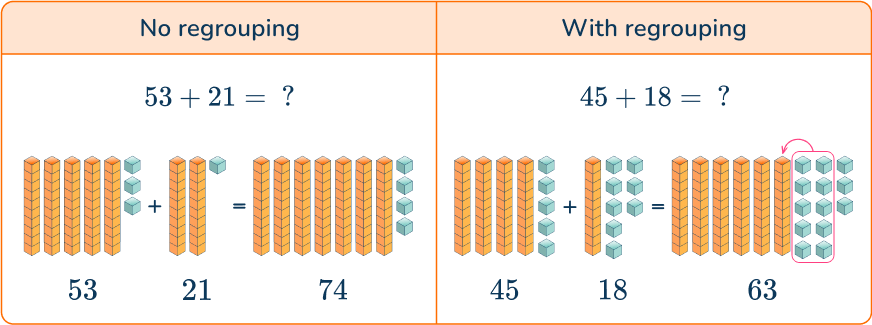
To subtract within 100 using base ten blocks:
- Draw the larger number, then cross off the number of tens and ones in the smaller number. Count the remaining tens and ones.
Note that if there are not enough ones to cross off, you’ll need to exchange 1 ten for 10 ones first. See the examples below.
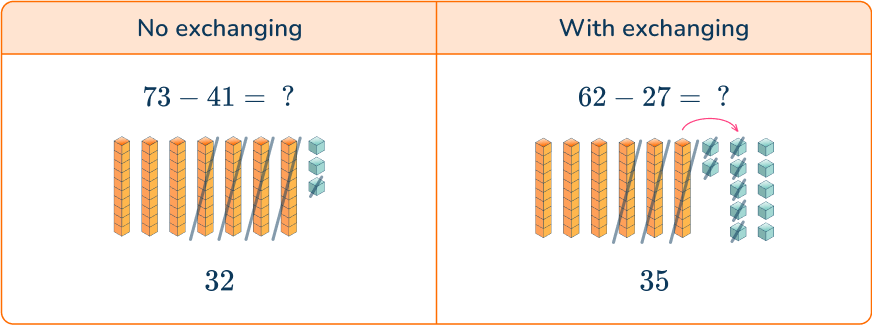
To add and subtract within 100 using a number line:
- Draw a number line and use it to visually add or subtract. Move forward on the number line for addition and backward for subtraction.

To add and subtract within 100 using mental math or the break apart strategy:
- Split each number into tens and ones. Add or subtract the tens. Add or subtract the ones together. Then combine the remaining tens and ones.
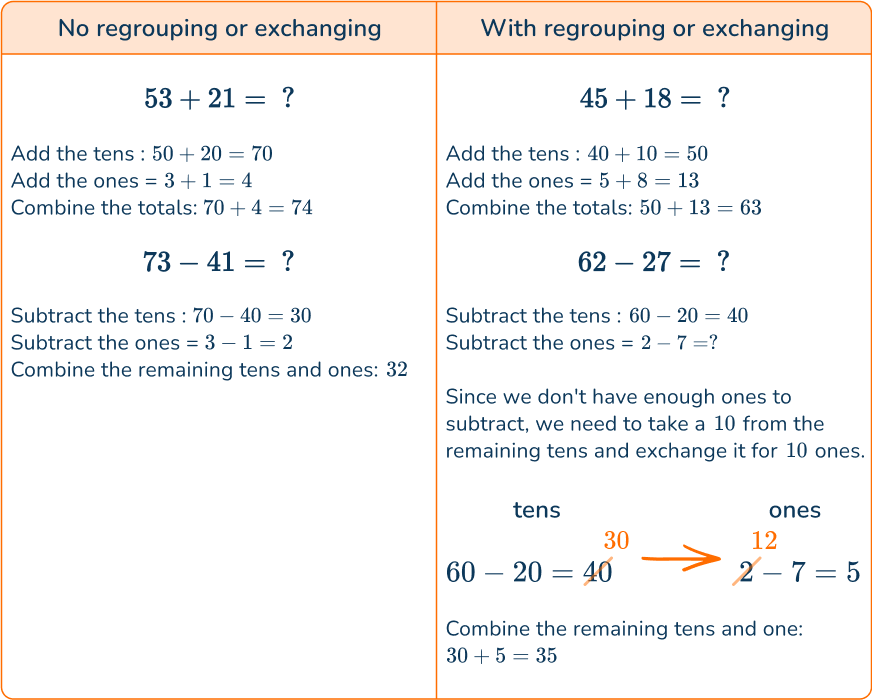
To add within 100 using the standard algorithm:
- Stack the numbers vertically, placing the larger addend on top; be sure to line up the place values correctly. Start by adding the numbers in the smallest place value (the ones place). If the sum is greater than 9, carry over the tens place to the next column. Continue adding each column, regrouping as needed, until all columns are added.
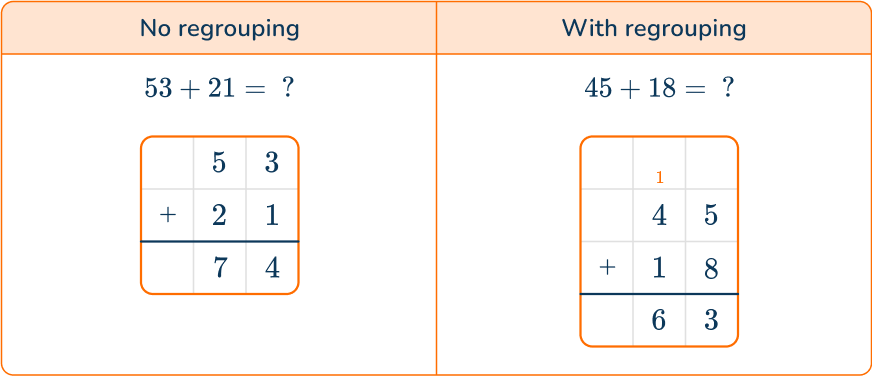
To subtract within 100 using the standard algorithm:
- Stack the numbers vertically, placing the larger addend on top; be sure to line up the place values correctly. Start by subtracting the numbers in the smallest place value (the ones place). If the digit on top is smaller than the one below, borrow from the next higher place value. Continue subtracting each column, borrowing as needed, until all columns are subtracted.
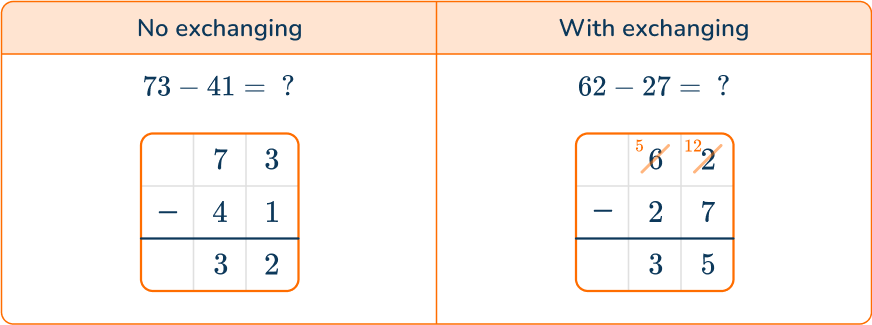
What is adding and subtracting within 100?

Common Core State Standards
How does this relate to 2 nd grade math?
- Grade 2: Number and Operations in Base Ten (2.NBT.B.5)
Fluently add and subtract within 100 using strategies based on place value, properties of operations, and/or the relationship between addition and subtraction.
- Grade 2: Operations and Algebraic Thinking (2.OA.A.1)
Use addition and subtraction within 100 to solve one- and two-step word problems involving situations of adding to, taking from, putting together, taking apart, and comparing, with unknowns in all positions, e.g., by using drawings and equations with a symbol for the unknown number to represent the problem.
![[FREE] Addition and Subtraction Worksheet (Grade 2, 3, 4 and 7)](https://thirdspacelearning.com/wp-content/uploads/2023/11/Addition-and-Subtraction-listing-image.png)
[FREE] Addition and Subtraction Worksheet (Grade 2, 3, 4 and 7)
![[FREE] Addition and Subtraction Worksheet (Grade 2, 3, 4 and 7)](https://thirdspacelearning.com/wp-content/uploads/2023/11/Addition-and-Subtraction-listing-image.png)
Use this quiz to check your grade 2, 3, 4 and 7 students’ understanding of addition and subtraction. 15+ questions with answers covering a range of 2nd, 3rd, 4th and 7th grade addition and subtraction topics to identify areas of strength and support!
DOWNLOAD FREE![[FREE] Addition and Subtraction Worksheet (Grade 2, 3, 4 and 7)](https://thirdspacelearning.com/wp-content/uploads/2023/11/Addition-and-Subtraction-listing-image.png)
[FREE] Addition and Subtraction Worksheet (Grade 2, 3, 4 and 7)
![[FREE] Addition and Subtraction Worksheet (Grade 2, 3, 4 and 7)](https://thirdspacelearning.com/wp-content/uploads/2023/11/Addition-and-Subtraction-listing-image.png)
Use this quiz to check your grade 2, 3, 4 and 7 students’ understanding of addition and subtraction. 15+ questions with answers covering a range of 2nd, 3rd, 4th and 7th grade addition and subtraction topics to identify areas of strength and support!
DOWNLOAD FREEHow to add and subtract within 100
In order to add and subtract within 100\text{:}
- Choose a strategy (Base ten, Number line, Break apart / Mental math, Standard algorithm).
- Solve.
Add and subtract within 100 examples
Example 1: two-digit addition (base ten blocks)
34 + 16 = \; ?- Choose a strategy (Base ten, Number line, Break apart / Mental math, Standard algorithm).
You can use base ten blocks to add. Set up using base ten blocks to represent each number.
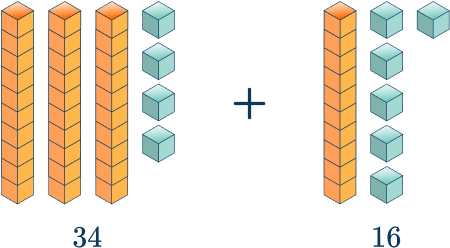
2Solve.
Combine the tens and the ones, then counting the total. For this problem, you’ll need to regroup 10 ones into 1 ten before counting the totals.
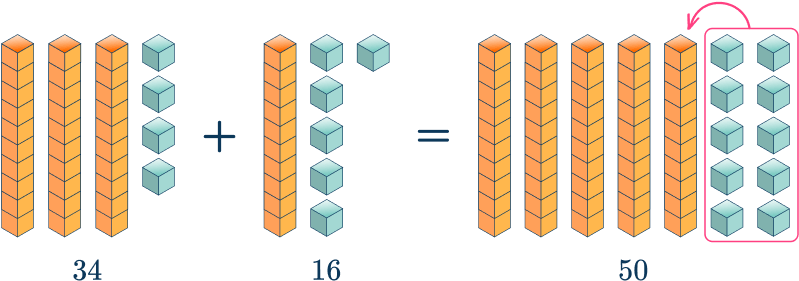
Example 2: two-digit subtraction (base ten blocks)
49-24=\; ?Choose a strategy (Base ten, Number line, Break apart / Mental math, Standard algorithm).
You can use base ten blocks to subtract. Set it up by using base ten blocks to represent the larger number only.
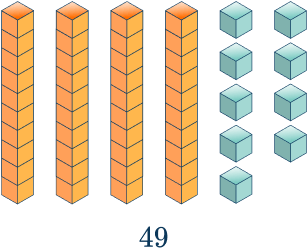
Solve.
Solve by removing the number of tens (2) and then the number of ones (4). Count the remaining tens and ones to get the answer.
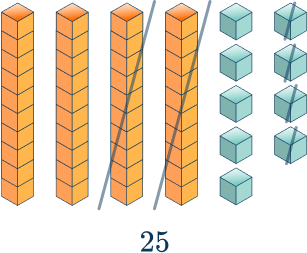
Example 3: two-digit addition (number line)
43 + 19 = \; ?Choose a strategy (Base ten, Number line, Break apart / Mental math, Standard algorithm).
Start by drawing a number line and marking the largest number at the front of the number line.

Solve.
Jump forward the number of tens in the second number. Then move forward to add the ones. This could be broken up to get to the next 10, and then add the remaining number of ones.

As an alternative to help with regrouping, you can jump just enough ones to get to a ten first. So in this case, instead of adding 7 ones at once, you add 7 to get to 50, then add 10 to get to 60, then add the remaining 2 ones.

Example 4: two-digit subtraction (number line)
76-28=\; ?Choose a strategy (Base ten, Number line, Break apart / Mental math, Standard algorithm).
Draw a number line and mark the largest number at the end of the number line.
Solve.
Jump backward the number of tens in the second number. Then move backward to subtract the ones. This could be broken down into two jumps.

Example 5: two-digit addition (break apart strategy)
68 + 31 = \; ?Choose a strategy (Base ten, Number line, Break apart / Mental math, Standard algorithm).
As your math skills get better, you can use the break apart strategy, helping with your mental math.
Start by breaking each number into tens and ones:
68=60+8
31=30+1
Solve.
To solve, add the tens, add the ones, then combine the total tens and ones.
Add the tens: 60+30=90
Add the ones: 8+1=9
Combine the tens and ones: 90+9=99
Therefore, 68+31=99
Example 6: two-digit subtraction (break apart strategy)
52-27=\; ?Choose a strategy (Base ten, Number line, Break apart / Mental math, Standard algorithm).
You can use the break apart strategy to subtract.
Start by breaking each number into tens and ones:
52=50+2
27=20+7
Solve.
To solve, subtract the tens and subtract the ones. Then combine the remaining tens and ones.
Subtract the tens: 50-20=30
Subtract the ones: 2-7=\; ?
Exchange 1 ten for 10 ones:
12-7=5
Combine the remaining tens and ones: 30+5=35
Therefore, 57-22=35.
Example 7: addition word problem (standard algorithm)
A farmer placed 38 red apples and 26 green apples into a basket. How many apples are in the basket altogether?
Choose a strategy (Base ten, Number line, Break apart / Mental math, Standard algorithm).
You can use the standard algorithm to solve this addition word problem.
To set it up, stack the numbers vertically, lining up the place values.
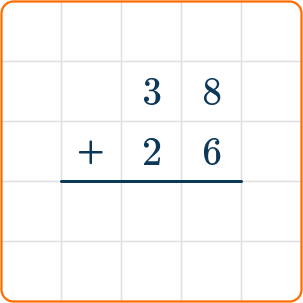
Solve.
To solve, add the digits in the ones column first. Since the sum of these two digits is greater than 10, you need to carry the ten to the next column (the tens column). Then you can add the digits in the tens column (along with the 1 ten that was carried over).
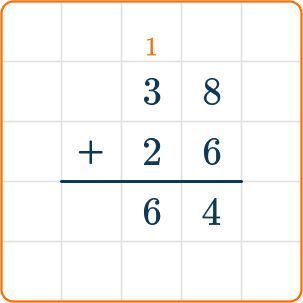
Example 8: subtraction word problem (standard algorithm)
Jack had 74 marbles. He gave 18 marbles to his friend. How many marbles does Jack have now?
Choose a strategy (Base ten, Number line, Break apart / Mental math, Standard algorithm).
You can use the standard algorithm to solve this subtraction word problem.
To set it up, stack the numbers vertically, lining up the place values.
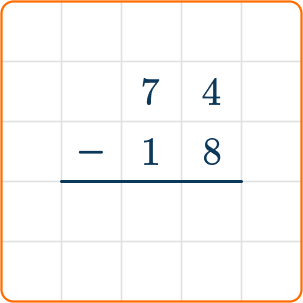
Solve.
To solve, subtract the digits in the ones column first. Since there aren’t enough ones in the number on top, you need to exchange a ten from the next column (the tens column).
Then you can subtract the ones, then the tens.
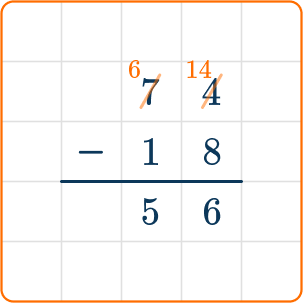
Teaching tips for adding and subtracting within 100
- Create printable worksheets with mixed addition and subtraction problems within 100 that include an answer key for students to self-assess their work and check for errors. (Start with just addition worksheets and subtraction worksheets before creating mixed worksheets.)
- Make room for math games and flashcards in lesson plans to allow students to continuously practice addition and subtraction facts. This will help prevent calculation errors when adding and subtracting within 100 and boost 1 st grade math skills.
- Use models such as number bonds to help students determine what operation to use when solving word problems.
- Give students completed examples of adding and subtracting using the standard algorithm with missing numbers and ask them to fill in the blanks. This will help them build a stronger understanding of the standard algorithm and prepare them for 3 rd grade math and beyond.
- Encourage students to use number bonds to determine if a word problem is an addition problem or a subtraction problem.
Easy mistakes to make
- Forgetting to regroup or exchange
Students may forget to regroup or exchange when the sum or difference exceeds 9 in one place value.
- Misaligning digits in the standard algorithm
When using the standard algorithm, digits must be stacked vertically, aligning the digits that are in the same place value. Not doing so will lead to calculation errors.
Related addition and subtraction lessons
Practice add and subtract within 100 questions
1. Solve 35 + 27.




Using base ten blocks:
Model the tens and ones in each number.
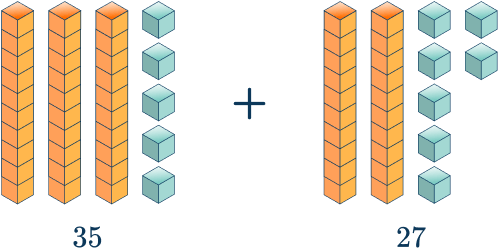
Combine the tens and ones.

You can create one new group of ten from 10 ones.

This leaves 6 tens and 2 ones, which is 62.
Therefore, 35+27=62.
2. Solve 94-58.




You can use a number line to count back from 94 to 58.

3. Solve 72+18=\; ?




You can use the break apart strategy to solve.
First, break each number into tens and ones.
72 = 70 + 2
18 = 10 + 8
Add the tens from each number.
70 + 10 = 80
Add the ones from each number.
2 + 8 = 10
Combine the tens and ones.
80 + 10 = 90
Therefore, 72 + 18 = 90
4. Solve 65-32=\; ?




You can use the break apart strategy to solve.
First, break each number into tens and ones.
65=60+5
32=30+2
Subtract the tens.
60-30=30
Subtract the ones.
5-2=3
Combine the tens and ones.
30 + 3 = 33
Therefore, 65-32=33
5. Solve 48+37=\; ?




You can use the standard algorithm to add the numbers.
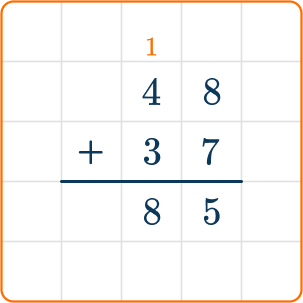
6. Solve 98-27 =\; ?




You can use the standard algorithm to subtract the numbers.
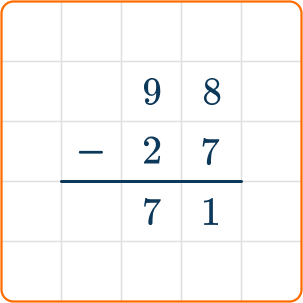
Add and subtract within 100 FAQs
You can add and subtract within 100 ( 2 digit addition and subtraction) using a variety of strategies based on place value, such as base ten blocks, number lines, break apart strategies, and the standard algorithm.
You can use place value understanding to add and subtract within 100 by breaking numbers into tens and ones, making it easier to perform regrouping or exchanging (carrying over or borrowing) when necessary.
You can use base ten blocks, number lines, the break apart strategy or mental math, and the standard algorithm to add and subtract within 100.
The next lessons are
Still stuck?
At Third Space Learning, we specialize in helping teachers and school leaders to provide personalized math support for more of their students through high-quality, online one-on-one math tutoring delivered by subject experts.
Each week, our tutors support thousands of students who are at risk of not meeting their grade-level expectations, and help accelerate their progress and boost their confidence.

Find out how we can help your students achieve success with our math tutoring programs.
[FREE] Common Core Practice Tests (3rd to 8th Grade)
Prepare for math tests in your state with these 3rd Grade to 8th Grade practice assessments for Common Core and state equivalents.
Get your 6 multiple choice practice tests with detailed answers to support test prep, created by US math teachers for US math teachers!